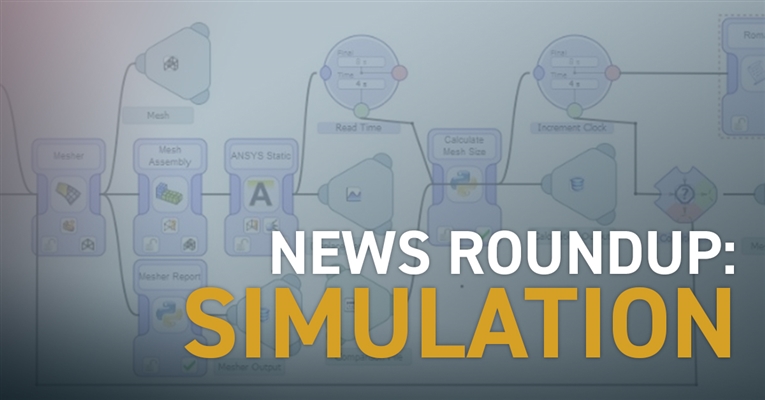Several recent articles highlight Aras’ acquisition of Comet Solutions in the Fall of 2018. They explore how the strengths of the Aras platform—openness, configuration management, flexibility, and scalability—address the challenges companies typically face when managing simulation.
This round-up summarizes three of them, and includes links to dive deeper into each article and topic…
1 - Connect Traditionally Siloed Simulation & Engineering Processes
Comet specializes in SPDM, or simulation process and data management, defined by Chad Jackson of Lifecycle Insights as “automation capabilities” to run simulation templates. “These are compelling capabilities,” he writes. “You can connect to several different tools for simulation and analysis.”
In keeping with the openness of the Aras platform, the ability to connect with customers’ existing simulation tools is a differentiator for the Comet technology. Unlike many other SPDM tools, it is not limited to one vendor’s set of authoring or analysis software, as the article describes.
With a wide range of available connectors, Comet can automate the inputs, pre-processing, simulation runs, and post-processing for not just one simulation tool at a time, but for many. This is compelling because the outputs of one simulation process can be used as the inputs for another in a tool-chaining approach capable of automating multi-physics, multi-fidelity simulation processes. Uniquely, Comet’s automation technology also allows a single template to work across an entire product family.
2 – Drive Strategic Initiatives with Simulation throughout the Product Lifecycle
Bruce Jenkins of Ora Research cites Aras Strategy VP Marc Lind in the 3DCAD World article, Aras lays out strategy for acquired Comet Solutions technology. “Without a new approach to SPDM, many of the strategic imperatives / Digital Transformation goals that rely on simulation will not be attainable.”
These strategic initiatives impact the entire product lifecycle—not just engineering. As Jenkins further cites Lind, they include the “Need to further reduce physical testing, complexity of smart connected product design / MBSE,” and “push for predictive maintenance through Digital Twins.”
Simulation is driving future innovations at more points throughout the lifecycle than ever before. It is moving upstream into systems design and analysis with MBSE and advanced “system of systems” designs; downstream to the field via Digital Twin simulations to drive predictive maintenance and root cause analysis; and even deeper into the manufacturing domain, underpinning new approaches like factory Digital Twins, additive manufacturing, and generative design.
Each new use case for simulation demands more from the tools and processes that simulation employs today. Simulation inputs, processes, and results must now stay connected with the product configuration to which they apply, to ensure the accuracy of findings, to allow for comparison across design iterations, and to provide access to simulation insights for more teams throughout the lifecycle. What’s more, simulations need the means to be repeated quickly and in an automated fashion each time designs iterate rapidly, to stay up-to-date with changes and variants across product families. In particular, today’s highly-manual, expert-centric simulation processes can no longer work – what’s required is robust simulation automation that works across design changes and even across entire product families. And, non-experts need a way to initiate simulation processes and view simulation results in context with other vital product information like requirements, quality processes, maintenance recommendations, and more – simulation automation techniques must be robust and safe for these non-experts.
3 - Scale Simulation to More Stakeholders across the Enterprise
In a manufacturing.net article, The Democratization of Simulation and Analysis, Mark Reisig, Product Marketing Director at Aras, describes the traditional specialization of simulation expertise and software. Simulation and analysis, he writes, “is now the fastest growing market segment in the PLM industry and has the potential to grow at an even greater rate. More importantly, it has the potential to break out of its niche, supporting product design, and into manufacturing and operations with more mainstream end users.”
But for simulation to “break out of its niche” and reach more organizational stakeholders – and more key strategic initiatives - requires a change, he writes, so that more engineers can access it and more processes can leverage it. Where simulation is managed must change—from the hard drives of CAE experts to a platform with access to more organizational stakeholders and tools—so that simulations can be associated with their related product information, accessed for broader insights, and repeated across lifecycle processes.
SPDM has promised for decades to make simulation more accessible across the enterprise and throughout the lifecycle. But is it working? Reisig’s article cites CIMdata’s opinion that SPDM “has been ‘an extreme disappointment’” due to its continued tendency to lock away simulation and analysis data on file servers that only simulation experts can access. Further evidence it’s not working? Its low adoption rate: less than 5% of CAE experts worldwide use SPDM today.
But a platform approach is different. “The value of this platform-based approach to SPDM is the democratization of S&A, enabling experts to package the built-in knowledge and methods, link it to the design, which can be accessed by many users without advanced simulation expertise, and then use the data to run further simulations. This can now be done across domains and throughout the lifecycle, with complete traceability back to the simulation and requirements that drove the original simulation.”
With a platform approach to managing simulation data and processes, like the one Aras offers, those who are not experts in simulation can access simulation through a straightforward user experience. They can initiate best-practice simulation processes using existing simulation technologies to maximize current investments in CAD and simulation software. Aras Simulation Management automates the capture and preparation of the correct input data to enable a multiphysics, multi-fidelity approach in context with the current right product configuration, and it automates post-processing and results communication to keep simulation information available with its associated product lifecycle data and design configuration, including relevant requirements, quality information, maintenance activities, manufacturing processes, and more.
For more information on Aras Simulation Management, check out the Aras eBook, A Guide to Simulation for Innovation, found on the Aras website.

